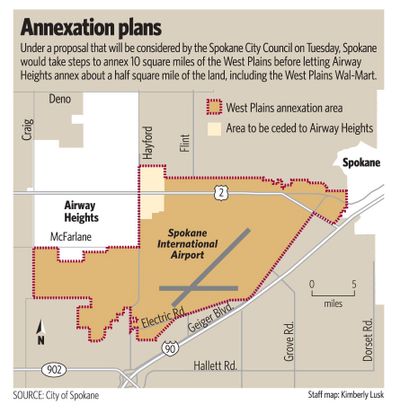Spokane, Airway Heights get together on annex plan

Spokane borders could soon be extended by 10 square miles in what would be the city’s largest annexation in more than a century.
The Spokane and Airway Heights city councils on Tuesday will consider an agreement that would divide much of the West Plains between the two cities. If the concept works as planned, Spokane would end up with most of the land, including Spokane International Airport, but Airway Heights would win the tax-rich Wal-Mart site.
Officials caution that the agreement is the first step of many. Final annexation decisions are made by the Spokane County Boundary Review Board, and often are challenged in the courts.
“We have not yet jointly engaged the property owners,” said Airway Heights Mayor Matthew Pederson. “These owners will still be heard and play a major part in the final form.”
The two cities have fought over the West Plains for years. Spokane’s effort to annex an even larger area of the West Plains in 2002 was challenged by Airway Heights. The effort also was opposed by some residents who questioned how the change would affect their rural lifestyles.
Although Airway Heights and Spokane administrators have settled key differences, numerous other complications could delay the process.
One serious consideration for Spokane leaders is an agreement it has with Spokane County Fire District 10, which serves almost 100 square miles of the West Plains. In 1999, Spokane officials agreed that if they attempted to annex a portion of the district that has a total property value equal to 60 percent or more of the total 1999 value of the district, Spokane would become responsible for providing fire service to the entire district.
District 10 Fire Chief Nick Scharff said he believes the land the city wants may reach the 60 percent level.
Airport officials reached Friday said they still were grappling with the implications of an annexation, including the effect of tax revenues generated on site from rental cars and other items.
“There are ramifications, but that would have to be worked out,” said airport Director Neal Sealock.
City Council President Joe Shogan, who also serves on the airport’s board, said annexation would change little about the airport’s operation. The airport is jointly owned by Spokane and Spokane County.
Most of the land that would become part of Spokane is airport property. But it also includes the Waste-to-Energy Plant and several businesses, including Triumph Composite Systems, which manufactures airplane parts.
The Boundary Review Board rejected Airway Heights’ request to annex about 600 acres, east to Flint Road, in 2003. Spokane leaders have argued they’re entitled to the land because much of the property all the way to Airway Heights receives sewer and water service from Spokane. Before allowing properties to hook up to city service, Spokane requires owners to sign documents agreeing to become part of the city.
The city is depending on those agreements to make the deal. A city can annex an area if owners accounting for 75 percent of the area’s property value want in to the city.
But because many of the most expensive properties receiving Spokane sewer and water service are closest to Airway Heights, Spokane would be unable to reach 75 percent of the value unless it annexes the full area – including portions it has decided to cede to Airway Heights. Under the agreement with Airway Heights, once Spokane annexes all of the land, it would quickly “de-annex” about a half square mile, including Wal-Mart, to allow it to become part of Airway Heights.
Pederson said Airway Heights isn’t interested in much of the land that would go to Spokane, including what’s on its southern border, because it’s owned by the airport and can’t be developed.
Both mayors praise the deal as a way to avoid lawsuits.
“Getting local governments to work together – if we’re successful – is a lot different than how things have been in the past,” Pederson said.
Spokane Mayor Mary Verner said if the agreement between the two cities falters, the city likely will pursue the full 10 square miles without ceding land to Airway Heights. But, she said, the deal is a better approach because it would allow annexation to proceed without infighting between cities.
“Mayor Pederson and I believe that we can set a new regional standard for a collaborative approach for annexation,” Verner said.
If approved by both city councils, Spokane would initiate the annexation process in March.
“It’s in our best interest to just complete the annexation,” Verner said. “We’re spending a significant amount of time and staff resources to pursue the details.”
The proposed area would make the West Plains annexation Spokane’s largest jump in size since it went from 20 to 37 square miles in 1907. Since then, the city has grown to about 60 square miles through more than 60 annexations, all of which have been less than four square miles.
Spokane took a more aggressive approach to annexation under Mayor Dennis Hession. His push to include the north Spokane Costco within city borders succeeded soon after he left office in 2007. The new borders will bring hundreds of thousands of dollars in sales taxes from county government into the city annually.
Jonathan Brunt can be reached at jonathanb@spokesman.com or (509) 459-5442.